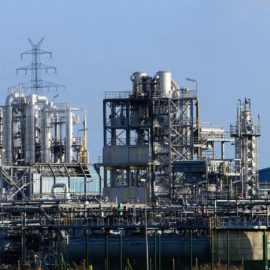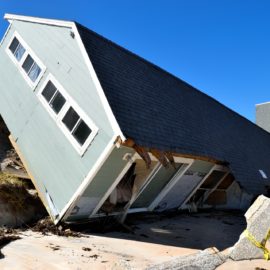
Mardi Gras Pass was saved by mud and the black willow tree.
Almost a decade ago, back-to-back high water years on the Mississippi River breached the east bank levee in lower Plaquemines Parish, forming a new crevasse connecting the river to the back levee canal within the Bohemia Spillway. What began as a trickle, too narrow for most boats, has widened each year as the water has forced its way through. Now the crevasse, known as Mardi Gras Pass, is more than 300 feet wide, with about 30,000 cubic feet of muddy water passing through each second. That might sound like bad news for a Louisiana coast that is losing land at a rate of a football field every 100 minutes. In fact, the crevasse is producing more land, much to the delight of some of the state’s coastal advocates.
nola.com
Mardi Grass Pass is now navigable and entering it you can see the trees.
Approach Mardi Gras Pass by boat from the north, and watch as black willow trees lining the back levee canal mature in newly built land closer to the crevasse, gaining height. Michael Hopkins, coast and community programs director for The Pontchartrain Conservancy, likens the transformation to traveling through time, watching the various stages of growth. “It’s almost like a natural experiment,” he said, as the boat whipped past the pioneer species growing amid a ghost forest of oak trees that, along with part of the marsh, were wiped out in 2005 by Hurricane Katrina’s salty storm surge. Since its opening in 2012, Mardi Gras Pass has been used by Hopkins and other coastal scientists to study how a cut in the riverbank can build land and form deltas. Now after Hurricane Ida, it might also offer an example of how a marsh newly sustained by sand and silt from the Mississippi is more resilient to storms.
The pass is by Port Sulphur and Venice so Ida hit it as it did the rest of this area.
Ida shoved a 16-foot wall of water over parts of southeast Louisiana on Aug. 29. Satellite imagery shows the storm likely ripped apart large swaths of wetlands in the Barataria Basin, off Plaquemines’ west bank, and converted them, at least temporarily, to open water. The basin has been in decline for decades, since the leveeing of the Mississippi River in the early 20th century disconnected it from new supplies of river sediment. But on the east bank near Mardi Gras Pass’ outfall and along the Bohemia Spillway, satellite photos before and after Ida suggest the marshes fared better. The difference? A steady source of sediment from the river through the crevasse, said Hopkins and National Wildlife Federation scientist Alisha Renfro.
The land around the pass has changed over the years and the before and after shots are striking.
Other satellite photos dating from when Mardi Gras Pass punched through the riverbank nine years ago show how mudflats and new marsh have emerged where John Bayou meets Uhlan Bay, as river sediment fills in the area leading to American Bay. Where Ida broke off chunks of flotant, or floating marsh, in Barataria Bay, the marshes on the backside of the Bohemia Spillway remained largely intact. For Kirk Songy, a recreational fisher who has been visiting the area with his father since the 1980, Mardi Gras Pass revived one of his favorite fishing spots. It delivered an influx of freshwater that chased off some prized species such as speckled trout, but it also bolstered others such as redfish and bass. He wants to see more done to allow the river’s muddy water to spread across the coast. “What impresses me the most about this is that this is not something that man did,” he said. “This is something that nature did. It did it because needed to happen.” Renfro, who advocates with the Restore the Mississippi River Delta Coalition for sediment diversions, said the crevasse and the spillway support the need for structures reconnecting the river to Louisiana’s rapidly degrading wetlands. “We can find productive ways to let it get out or see it happen in catastrophic ways,” she said.
Plaquemains Parish has a couple of projects underway.
Louisiana’s 50-year, $50 billion plan to shore up its lower third includes two major Plaquemines projects, the Mid-Barataria Sediment Diversion and the Mid-Breton Sediment Diversion, to build land with even more river water than Mardi Gras Pass allows. Both are a source of controversy between the coastal authority and fishers who fear the effect on their industry. The Pontchartrain Conservancy plans to monitor Mardi Gras Pass and its influence for decades to come, looking to glean whether land-building will continue or plateau. Hopkins said the nonprofit is also watching how the ecosystem progresses in a period of change. But the future of the crevasse remains murky. The channel that delivers fresh water year-round leaves that part of the coast unsuitable for the oyster reefs that once thrived on Plaquemines’ east bank. The population of bivalves had been in decline before the crevasse opened, but Mardi Gras Pass sounded the death knell. Oyster harvesters have pushed for years to close the channel, said Mitch Jurisich, who leads the Louisiana Oyster Task Force. In 2017, they funded a $200,000 engineering study to determine how that could be done. Six months ago, they applied for a coastal use permit to move the effort forward.
With this opposition, will Mardi Gras Pass remain?
Jurisich said it would cost $8 million, money that has yet to be secured. The state’s Coastal Protection and Restoration Authority has stated it wouldn’t block the effort and would support installation of a new salinity control structure, but the agency will not fund the crevasse’s closure. Should the push to close Mardi Gras Pass succeed, Jurisich expects the bivalves to return as salinities rise. “I’m not saying it would be a full-fledged production, but you will see oysters begin to come back,” he said. “It’ll take years for them to rebound to what they used to be because when you go up from basically zero oysters back to $50 million a year industry, it’s going to take a while.”
What nature does is not always what is economically sound. Then man changes thing and will that be better? Time will say.



